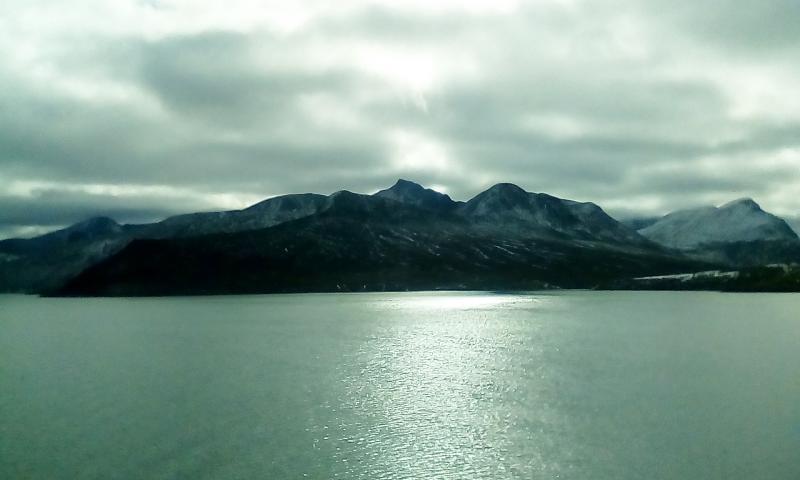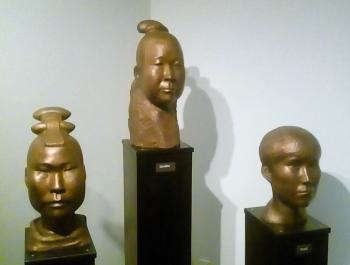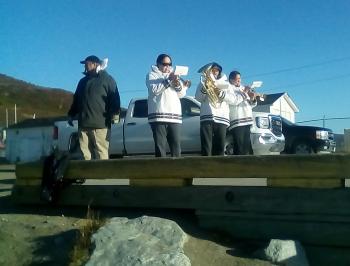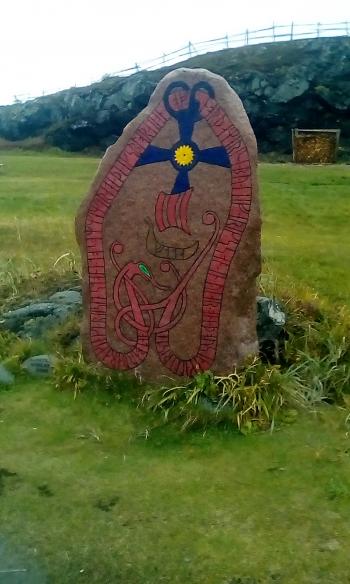Exploring the harshly beautiful landscapes of Greenland and Canada’s Labrador
This article appears on page 6 of the May 2018 issue.
My love affair with the Arctic and subarctic began years ago when I flew over the great Greenland Ice Sheet when returning from a trip to Europe. Stunned by the sight of an enormous island of ice, I began making at least one trip a year to an Arctic region and have never been disappointed with the scenery, wildlife, indigenous cultures or even the weather.
My latest choice was offered by Adventure Canada (Ontario, Canada; 800/363-7566, adventurecanada.com); “Greenland & Wild Labrador 2017” visited some of the most remote places on Earth from the comfort of the Ocean Endeavour, a 198-passenger expedition vessel.
A few details
The total cost for single accommodations was $6,725, including air from Cleveland to Toronto and return from St. John’s, Newfoundland, as well as a charter flight from Toronto to Kangerlussuaq, Greenland, where I boarded the ship. I also bought private insurance with Allianz (allianztravelinsurance.com) for $825.
In addition, each passenger was expected to pay $250 in tips to the ship’s staff at the end of the voyage. The trip cost, itself, included a $250 “Discovery Fee,” which the company used to support chosen causes.
The Sept. 23-Oct. 7 tour started at the Sheraton Gateway Hotel at Toronto’s Pearson International Airport, where the group gathered on the evening of Sept. 22 for an informational meeting and buffet dinner. We reunited at 5:30 the next morning to walk over to the airport for the charter flight on Air Transat. Like most people in the group, I had booked a night at the hotel for $115, since getting to the terminal at 5:30 a.m. would have been difficult otherwise.
All of Adventure Canada’s arrangements, including booking the hotel room, sending instructions for joining the group (received before departure) and leading the group to the Air Transat desk, were seamless, and the 5-hour flight to Greenland was very comfortable.
Setting sail
Greenland, the world’s largest island, is covered by an immense (1 to 2 miles thick), though rapidly melting, ice sheet. Its 57,000 inhabitants live mainly along the narrow margin of the ice.
We enjoyed a brief visit to Kangerlussuaq, set on Sondre Stromfjord, which, at 105 miles in length, is the second-longest fjord in Greenland. The airstrip there dates back to World War II, when the strategic value of a polar route led to the building of several airports in Greenland.
A short bus trip and a brief Zodiac ride took us out to the Ocean Endeavour. Our luggage was handled by the staff and delivered to our cabins very quickly.
A lunch was welcome, since only sandwiches were served on the flight, and just as welcome was my room upgrade, provided because I’d taken two previous trips with Adventure Canada. I was assigned a double room with a window (limited view) rather than the single with a porthole that I had expected.
That first night, the call went out signaling Northern Lights, but I slept through it. Those who went on deck said that the view was spectacular.
Village visit
The next morning brought a Zodiac cruise along the face of a glacier near Kangaamiut village, the ice much diminished over the past few years, according to our guide.
The Arctic is more sensitive to climate change than other areas of the planet. As the reflective snow and ice melt, it reveals more water, which absorbs, rather than reflects, heat. This, in turn, speeds the melting.
However, cruising along a glacier is still an awe-inspiring experience, even as it reminds us of harsh changes in the works.
Next, we stopped at Kangaamiut, itself, a small whaling village of about 350 Greenlanders at the entrance to Evighedsfjord. We climbed around the various brightly painted buildings perched high on rocks jutting up out of the water, also visiting a school and a small museum that featured mainly local paintings and tupilaks, carvings in tooth, bone or stone. I have seen such carvings only in Greenland; they relate to an ancestor’s soul or spirit, and they are sinister-looking figures, possibly a reflection of the dangers lurking in such a hostile environment.
Note that all venues on this trip could be reached only by Zodiac (inflatable boat). People with mobility difficulties could have problems getting into and out of a pitching rubber boat, despite the helpful strong arms of the experienced staff.
A modern city
Greenland’s capital, Nuuk (our next stop), was as different from Kangaamiut as was possible. A large, modern city (population about 17,000) with a university, it is set against the backdrop of Sermitsiaq Mountain. High-rises, paved roads and modern buildings and shops show the modern world that Greenland has arrived.
We visited the Greenland National Museum, where the most famous exhibit displays eight mummified bodies of native Greenlanders dating back to the late-15th century. These Qilakitsoq mummies, all beautifully dressed, were preserved due to favorable soil and weather conditions.
The best preserved, a 6-month-old boy, shared his site with another boy and six women, all of whom met natural deaths and all of whom were related.
The experience of looking at the mummified bodies was like looking directly into the past of people like us. Who were they? How did they die?
I walked around the town for a while, admiring the high-rises and the many boats in the harbor. I got a coffee at the spectacular new Katuaq cultural center, which offers films, concerts and art, before catching the ship’s shuttle back to the Ocean Endeavour, enjoying a guided tour along the way.
We spent the next day crossing the Davis Strait, plowing through 35-foot waves. Tossing around in a well-stabilized, modern ship, I could only imagine how it was for the early explorers from the 16th century in their tiny wooden, wind-driven vessels, not to mention the hunters in their kayaks.
On the ship
On board, we had some free time to browse the well-stocked library and enjoy tea and cookies. My only complaint about the ship was the lack of quiet space.
There were two lounges, one of which was in almost constant use for lectures or workshops on various subjects, including glaciers, plastic pollution in the oceans, art and local culture. The second lounge must have recently undergone a face-lift, since the smell of vinyl from the seat covers was almost overpowering. I could never sit there for more than a few minutes.
The library was more of an open area, with comfortable seats and a coffee/tea station, but with many conversations going on, it was not a quiet area.
The food and cabin service generally were excellent. The chef was French, and all of our meals were wonderful — varied, tasty and generous.
I am a vegetarian, and I had no trouble finding plenty to eat. Certain dishes were marked “vegetarian,” “vegan,” gluten free” and so on for those with special diets.
Breakfast and lunch were buffet-style; dinner was served at the table, and the selection of wines (additional cost) was excellent.
The rest of the crew represented countries around the world: India, Russia, Panama, Ukraine, the Philippines and Indonesia. In addition, we had on board a team of divers who took every opportunity to dive at our various stops, later reporting on their finds, with pictures, at either the evening recap before dinner or during a day lecture.
Modern life
After crossing the strait, we arrived to a very warm welcome at Kangiqsualujjuaq, formerly known as George River, in the Northern Quebec autonomous region of Nunavik.
The town’s population of about 1,000 did everything they could to welcome us. A group came on board, led by the mayor, to talk about their community and the immense changes it had seen. One man explained that he had been born in a tent, and, growing up, he had no idea that there were people in the world beyond their group.
Onshore, the locals set up tents to serve bannock and tea, sell books and just allow us to warm up.
We were encouraged to visit the public buildings, such as the co-op store, where the prices of fresh vegetables and fruit were heart-stopping. People still live as much as possible off the land, although the local caribou herd, once the largest in the world, is in drastic decline.
As a former teacher, I naturally wanted to visit the local school and joined some other passengers on a tour guided by the school principal.
Many of the older people are monolingual, but it is a new world. Realizing that many young people will leave the town, the authorities have created a modern curriculum. All the young people have Inuktitut as their first language, but they then learn either English or French so they can eventually pursue higher education.
First Nations communities face unusual challenges, just as Native American communities do in the United States.
For young people who simply can’t accept book learning, for example, the school permits them to follow an outdoor curriculum that allows them to qualify as park rangers or guides.
Alcoholism and drugs are both problems, so the community has established a safe house to protect families.
Minding the weather
Back on board, we prepared to head south to visit Torngat Mountains National Park, electing to attend a lecture, read or nap the rest of the day away.
An innovation with Adventure Canada is the absence of paper. Most ships provide a printed daily schedule the night before, but on the theory that the absence of paper is an eco-friendly initiative, the staff instead gave an evening briefing, and the next day’s schedule ran continuously on the in-cabin TV sets.
The spectacular national park, all surging peaks, ice and huge skies, appeared to be barren, but it has been home to Inuit and earlier cultures for thousands of years. Its deep fjords are reminiscent of Norway’s, and the highest peak reaches 5,400 feet.
After we entered Eclipse Sound, we were told the presence of polar bears made a planned onshore hike impossible.
Both black and polar bears claim this land, along with caribou, falcons and eagles. Whenever we did go ashore in bear country, the staff established an armed human “bear perimeter” within which we were bound to stay.
Our plans for the next couple of days swung back and forth with the wind, literally. We managed a Zodiac cruise to North Arm and a landing in the afternoon at Torngat Mountains Base Camp & Research Station, which hosts international researchers and provides a base for exploring the 900-foot-high cliffs, 4-billion-year-old rocks and 7,000-year-old archaeological sites. First canceled due to high winds, this brief excursion was reinstated late in the afternoon.
A barbecue lunch on deck helped make up for the short time onshore.
Unfortunately, high winds the next day — 80 mph — forced cancellation of the excursion to visit the Moravian settlement at Hebron. Our trip leader, Jason, showed us the weather map, featuring winds screaming down the Labrador coast, so the only sensible thing to do was get out of Dodge. As always in the Arctic, flexibility is the order of the day. You can’t fight Mother Nature.
Lights on the shore surprised me the next morning. Because our area of travel was so remote, I had become used to missing signs of habitation. Arriving at Nain, Labrador’s capital, the lights felt welcoming.
Celebrating uncertainty
Traveling in the Arctic brings constant uncertainty. We might be kitted out and ready to step onto a Zodiac when a landing has to be canceled because of wind gusts, for example. You just shrug your shoulders and get on with it. That’s the way it is.
Likewise, the uncertainty can lead to wonderful experiences. One of our tour leaders had stayed as a youth in Indian Harbour, where his grandfather had worked as a doctor, and he proposed a visit. We went off to see the site of the former settlement, now nothing but ruined foundations, and it became a magical experience.
The Moravians had created a hospital there, where countless families established their fishing camps each year and were able to receive medical care.
As usual, the staff had established a bear perimeter, creating a striking picture silhouetted on the high ridge that bore a stunning likeness to a reclining Indian (hence the name of the village).
We meandered across the spongy terrain among the ruins of houses, the hospital and a graveyard with a few overturned tombstones. I finally just sat down to drink it all in. Some places just speak to the soul, and this was one of them.
L’Anse aux Meadows
We encountered European civilization once again at L’Anse aux Meadows, the only fully documented Viking site in North America. While the “Saga of Erik the Red” speaks of Leif Erikson’s landings around AD 1000 at Helluland (Land of Flat Rocks), probably Baffin Island, Markland (Timberland), most likely Labrador, and Vinland (Land of Grapes), or Newfoundland, archaeological evidence of Norse settlement is limited.
In the 1960s, the husband-and-wife archaeologist team of Helge Ingstad and Anne Stine Ingstad began excavation of what were thought to be Indian burial mounds. They found eight complete sod-and-wood houses and part of a ninth, dating to around the year 1000. The debris in the buildings indicated their various purposes, serving as an iron smithy, a carpenter’s shop or a boat-repair shop.
Anywhere between 30 and 150 people could have lived there, although the settlement was abandoned only a few years after it was established.
I had been to L’Anse aux Meadows once before, but my time there had been too limited, so I was glad to revisit it. This was our only day of truly bad weather, but even in the pouring rain, the site was very evocative.
Costumed interpreters sat around a fire in the typical Viking longhouse and explained their crafts and way of life. The excellent displays in the visitors’ center put the site into context.
St. John’s
Our final day started with an incredible vision: the entrance to the Narrows at St. John’s, Newfoundland. It was awe-inspiring, especially at dawn. As we slipped between the high rocks framing the lights downtown, it was like descending into a fairy kingdom.
We docked quickly and disembarked to find our luggage, which we had put outside our rooms the night before. A friendly local woman brought her equally friendly, huge Newfoundland dog down to greet the ship — a warm welcome, indeed.
Many of the passengers had elected to stay on in St. John’s for a few days, including me. Most stayed at the Delta St. John’s Hotel as part of a prepaid package arranged by Adventure Canada. I elected to stay at the Extended Stay St. John’s (222 LeMarchant Rd.; phone 709/754-7888), just outside the downtown area, where I had stayed two years earlier on another Adventure Canada trip. At $125 per night, including a Continental breakfast, the small hotel suited me well.
While there, I particularly wanted to revisit The Rooms (www.therooms.ca), a world-class museum featuring the history of Newfoundland & Labrador. Early cultures, immigration, the cod industry and all aspects of life in the province are represented by a million natural history specimens and another million artifacts.
However, I very nearly missed my chance. A water main break caused the museum to be closed on that Saturday, and that Monday was Canadian Thanksgiving, so I was lucky to have an extra day to see the exhibits. As it was, I spent a day walking around the town to view the unusual local architecture and the colonial buildings left from the days when Britain governed Canada, also browsing the very few shops that were open on the 3-day weekend.
In addition to its collection, The Rooms offers huge windows overlooking the Narrows and Signal Hill, where Guglielmo Marconi received the world’s first transatlantic wireless signal in 1901 and from which harbor defenses have protected St. John’s from the 17th century to the Second World War.
Sitting and taking in the view was relaxing and inspiring.
Labrador had been on my Arctic to-do list for a long time, and I was pleased to finally visit this remote region. The spectacular sights and the contrasts between nature and culture made for a varied experience, and I came away feeling once again, as I had after many trips abroad, that I had learned a lot about a hitherto unknown-to-me region of the world.




